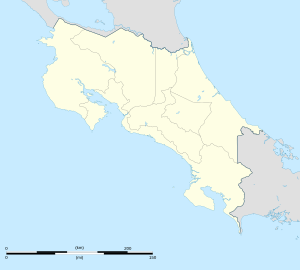Kéköldi facts for kids
Quick facts for kids
Kéköldi
|
|
|---|---|
| Country | Costa Rica |
| Province | Limón |
| Canton | Talamanca |
| Area | |
| • Total | 36,000 ha (89,000 acre) |
| Elevation | 0 m (0 ft) |
| Population | |
| • Total | 210 |
| Time zone | CST (UTC−06:00) |
The Indigenous Territory of Kéköldi is a special area in Costa Rica. It is home to about 210 people from the Bribri group. This territory was set up in 1977 to protect their land and culture.
Kéköldi is part of the Talamanca-Caribe biological corridor. This huge natural area covers about 36,000 hectares. It is located in the Talamanca region of Limón Province. Since 1994, a group called the Kéköldi Wak ka Köneke Association has managed the reserve. They work hard to keep Bribri culture alive and protect the land. They also buy more land to plant trees and help nature. Most people in Kéköldi speak both the Bribri language and Spanish. The reserve has a special station for scientists to study nature. It also has a place for tourists to watch birds.
Contents
Environment and Wildlife
The Kéköldi reserve has different types of forests. Some parts are primary forest, which means the trees have never been cut down. Other parts are secondary forest, where trees have grown back after being cut. There is also a special area where the community has planted new trees. These trees include those used for wood, medicine, and fruit. They also grow plants like palm, pejibaye (a type of palm fruit), and cocoa.
The Bribri people in Kéköldi have a cool project. They raise green iguanas. These iguanas are grown for food and then released into the wild. This helps keep the iguana population healthy. The reserve is also important because it contains the sources of the Aköldi and Kéköldi rivers. These rivers provide fresh water to nearby towns like Puerto Viejo. Because of its rich bird life, BirdLife International has named Kéköldi an Important Bird Area.
History of Kéköldi
Early Settlements
In the 1920s, indigenous people, including the Bribri and Cabécar, moved to the Kéköldi area. They worked on cocoa farms along the coast. Later, they started their own farms and settled there. In the 1930s, diseases like measles spread in the Talamanca mountains. This caused more people to move closer to the coast.
Creating the Reserve
In 1973, the Legislative Assembly of Costa Rica (Costa Rica's main law-making body) asked a group called CONAI to help indigenous communities. In 1976, President Daniel Oduber Quiros signed a special order. This order explained how indigenous reserves would be set up. Later that year, more orders created several indigenous reserves. One of these was the Talamanca Indigenous Reserve, which included the Cocles (Kéköldi) area. The Legislative Assembly officially approved this on November 16, 1977. This became Indigenous Law No. 6172.
In 1985, Kéköldi became its own independent reserve. Before this, it was part of the larger Talamanca Reserve.
Challenges and Conservation
When the reserves were first created, it was hard to draw the exact borders. Engineers used aerial photos, but they couldn't tell the difference between cocoa farms and natural forests. Many of these farms were owned by people who were not indigenous. The original plan for Kéköldi was about 3,538 hectares. By 1986, only 38% of the farms in the reserve belonged to indigenous people.
The Kéköldi Association asked the government to make the reserve smaller. They wanted to reduce it to 2,023 hectares. This was because CONAI didn't have enough money to buy all the farms from non-indigenous owners. However, the government said no. They explained that the 1977 Indigenous Law does not allow reserves to be made smaller. CONAI also refused, worrying it would set a bad example for other reserves. Even in 1993, the reserve's borders were not clearly marked. This made it difficult to stop people from illegally settling, hunting, or cutting trees.
Iguana Program and Forest Rules
The Kéköldi Association's iguana program is a special project. It teaches people how to raise iguanas. This program gets help from the Costa Rican Ministry of Natural Resources, the government of Norway, and a group called Asociacion ANAI. The first female iguanas were taken from Cahuita National Park and returned after laying eggs. The Kéköldi Association also helps train people from other indigenous reserves to raise iguanas.
If anyone wants to cut down trees in the Kéköldi reserve, they need permission. They must get approval from the Kéköldi Association and the Costa Rican Forestry Department. If the wood is sold, the money must be shared among all the indigenous people in the reserve. This helps make sure the forest is used wisely and benefits the whole community.
See also
In Spanish: Kéköldi para niños


